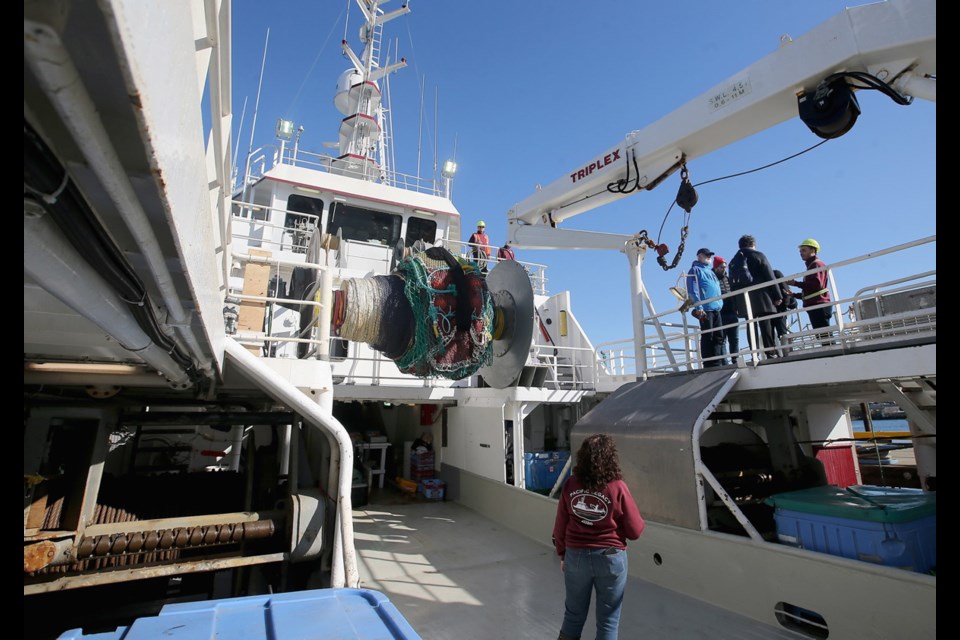The Pacific Legacy No. 1 set sail from Victoria for the high seas on Wednesday, equipped with a huge multi-coloured trawl net to catch salmon for an onboard team of international scientists tasked with figuring our their innermost secrets.
What is uncovered during 25 days at sea and through continuing study onshore is intended to help explain what is happening to struggling Pacific salmon stocks as ocean conditions change in the North Pacific.
“Last year, we had the lowest commercial catch of salmon in the history of B.C. and also the lowest catch of commercial salmon in Japan. But, at the same time, we got historic high catches in Russia and Alaska,” said Richard Beamish, one of the organizers of the $1.45-million expedition, at the launch at Point Hope Maritime.
“What we are missing are the pieces of the puzzle that allow us to see the big picture. That’s what this expedition is about.”
The voyage is the second of three consecutive annual expeditions to the Gulf of Alaska. It launched as Fisheries and Oceans Canada painted a bleak picture for this year’s fishing season, predicting returns will be as low as last year.
The expeditions are “doing something that has never been done before,” Beamish said.
Results “will eventually allow us to understand the mechanisms that regulate salmon abundance and then that will allow everybody to be professional stewards,” he said.
It will “make discoveries that will eventually change how we manage Pacific salmon. I’m absolutely certain about that.”
The trawl net, 30 metres deep and 40 metres wide at the opening, will haul in hundreds of Pacific salmon and other species, perhaps more. The chartered B.C. vessel is carrying a dozen scientists, an eight-member crew and sophisticated research equipment.
Scientists will examine a wide range of subjects, from fish health, ages, pathogens and stomach contents to nucleic acids. They will study environmental DNA within seawater samples. The scientists will look at phytoplankton, at the base of the food chain, and zooplankton to study prey, said Christoph Deeg, a chief scientist on the trip.
Beamish, emeritus scientist at Fisheries and Oceans Canada’s Pacific Biological Station in Nanaimo, and Brian Riddell, science adviser for the Pacific Salmon Foundation, raised the funds for the expedition from the public and private sector, non-profit organizations and individuals.
Scientists are testing the hypothesis that “juvenile salmon that grow faster and quicker in the first months in the ocean are the ones that can survive best in the first ocean winter,” Beamish said.
Dan Nomura, president of the Vancouver-based Canadian Fishing Co., said the expedition is relevant not only to salmon, but to other species as well.
Thousands of commercial fishermen in B.C. and Alaska depend upon salmon for their livelihoods, he said.
Agriculture Minister Lana Popham said the B.C. Salmon Restoration and Innovation Fund, funded by the provincial and federal governments, contributed $650,000 to the expedition.
Money raised this year will also pay for a fall symposium in Russia to review results from this year and last.
The government fund has also put in $3 million to support salmon, including next year’s planned pan-Pacific expedition, Popham said. That voyage is being organized by the International Year of the Salmon program through the North Pacific Anadromous Fish Commission.
Canada’s new B.C.-built offshore fisheries research vessel, the Sir John Franklin, will be used next year, said John Holmes, manager of the stock assessment division at the Pacific Biological Station.
Scientists from Canada, Russia and the U.S. are on this year’s expedition. The next survey, similar to 2019, will see participation from Japan and Korea.
Holmes said salmon in B.C.’s freshwater and on the continental shelf are accessible for study, which is not the case for those in the ocean.
“We’ve got little direct evidence of what happens to salmon in the black box of the high seas marine environment,” he said.
“But we know that the Pacific ecosystem is changing and that there are gaps in our understanding of these changes, particularly as they affect Pacific salmon.”
The benefit of the high seas work is that countries are collaborating, Holmes said. “The North Pacific is too vast for any one country to do the job on its own.”



